Rodeo Sponsorship Letters
[Your Organization's Logo or Letterhead]
[Your Organization's Name]
[Your Organization's Address]
[City, State, ZIP Code]
[Your Phone Number]
[Your Email Address]
[Date]
[Recipient's Name]
[Recipient's Title]
[Recipient's Organization]
[Recipient's Address]
[City, State, ZIP Code]
Dear [Recipient's Name],
I hope this letter finds you well. We are excited to introduce you to an incredible opportunity to showcase your brand and support a vibrant community event – the [Event Name] Rodeo, scheduled to take place on [Event Date] at [Event Location].
The [Event Name] Rodeo has become an annual tradition, eagerly anticipated by rodeo enthusiasts and families alike. Our event brings together participants from across the region, drawing a diverse audience of all ages. From heart-pounding rodeo action to live entertainment, food, and interactive experiences, our rodeo offers a unique platform for businesses like yours to gain remarkable exposure and create lasting connections.
By becoming a sponsor, you will enjoy a range of benefits tailored to meet your marketing objectives:
**[Sponsorship Level] Sponsorship:**
- Prominent logo placement on event banners, signage, and promotional materials.
- Booth space in our bustling vendor area, providing direct interaction with attendees.
- Recognition in our press releases and media coverage, maximizing your brand's reach.
- Social media mentions and cross-promotion to our engaged online community.
**[Sponsorship Level] Sponsorship:**
- Logo visibility on event banners and select promotional materials.
- Reserved VIP passes for you and your team to enjoy exclusive rodeo experiences.
- Inclusion in our event program, distributed to attendees.
We are committed to making a positive impact with this year's rodeo. Your sponsorship will directly contribute to enhancing the event's quality, supporting local charities, and providing opportunities for youth involvement in our community.
We would be delighted to discuss the various sponsorship levels in more detail and tailor a package that aligns with your brand's objectives. Please feel free to contact our sponsorship coordinator, [Coordinator's Name], at [Coordinator's Phone Number] or [Coordinator's Email Address], to explore the possibilities further.
Thank you for considering this unique opportunity to partner with us. Your support will not only showcase your commitment to our community but also create a memorable experience for all rodeo attendees.
We look forward to the possibility of working together and creating a successful partnership.
Sincerely,
[Your Name]
[Your Title]
[Your Contact Information]
[Attachments: Sponsorship Brochure, Event Flyer, Previous Rodeo Highlights (optional)]
Letter 1: Initial Rodeo Sponsorship Request to Local Business
Dear [Business Name/Owner],
I hope this letter finds you well. My name is [Your Name], and I am writing on behalf of [Rodeo Event/Organization Name], scheduled to take place on [Date] at [Venue/Location].
Our rodeo has been a cornerstone of our community for [X years], drawing [estimated attendance] spectators annually and showcasing the best of western heritage and athletic competition. This year, we are seeking partnership with local businesses like yours to help make this event even more successful.
We are offering several sponsorship levels ranging from $[lowest amount] to $[highest amount], each providing excellent visibility for your business. Benefits include logo placement on event materials, announcements during the rodeo, social media promotion to our [X thousand] followers, and complimentary tickets for you and your staff.
Your support would directly contribute to [specific use: prize money for competitors, facility improvements, youth rodeo programs, etc.], ensuring our event continues to bring economic vitality and entertainment to our community.
I would love to schedule a brief meeting to discuss how we can create a partnership that benefits both the rodeo and your business. I will follow up with you next week, or you can reach me directly at [phone] or [email].
Thank you for considering this opportunity to be part of our rodeo tradition.
Sincerely,
[Your Name]
[Title]
[Organization Name]
[Contact Information]
Letter 2: Corporate Sponsorship Proposal (Formal)
Dear [Corporate Executive Name],
Subject: Strategic Partnership Opportunity - [Rodeo Name] Sponsorship
On behalf of [Organization], I am pleased to present a sponsorship opportunity for the [Year] [Rodeo Name], taking place [dates] in [location].
Our event attracts [X thousand] attendees representing diverse demographics, with [X%] traveling from outside our immediate region. This provides exceptional brand exposure across [geographic area] and aligns perfectly with companies seeking to connect with [target demographic: families, outdoor enthusiasts, western lifestyle consumers, etc.].
We have developed a comprehensive sponsorship package specifically designed for corporate partners:
TITLE SPONSOR LEVEL ($[amount]): Exclusive naming rights, premium logo placement across all marketing channels, VIP hospitality suite, speaking opportunity at opening ceremonies, and exclusive digital content partnership.
PLATINUM LEVEL ($[amount]): Arena naming rights, prominent signage, vendor booth space, social media campaign inclusion, and [X] VIP tickets.
GOLD LEVEL ($[amount]): Event category sponsorship, rotating digital advertisements, program advertisement, and [X] tickets.
All sponsorships include comprehensive pre-event, during-event, and post-event marketing across our website, email newsletters, press releases, and social media platforms reaching [X] combined followers.
Enclosed please find our detailed sponsorship prospectus outlining deliverables, audience demographics, and partnership benefits. We are also open to customizing packages to align with your specific marketing objectives.
I would appreciate the opportunity to discuss this partnership in greater detail. I am available at your convenience and can be reached at [phone] or [email].
We look forward to the possibility of partnering with [Company Name] to create an unforgettable rodeo experience.
Respectfully,
[Your Name]
[Title]
[Organization]
[Contact Information]
Enclosure: Sponsorship Prospectus
Letter 3: Thank You Letter to Rodeo Sponsor (Heartfelt)
Dear [Sponsor Name],
I am writing to express our deepest gratitude for your generous sponsorship of the [Rodeo Name]. Your support made an incredible difference, and we couldn't have achieved such success without partners like you.
Thanks to your contribution, we were able to [specific accomplishment: increase prize purses for competitors, provide free admission for 200 children, upgrade our facilities, expand our youth education programs, etc.]. The impact of your generosity extended far beyond the arena—you helped create memories that will last a lifetime for thousands of families.
The feedback from our community has been overwhelmingly positive. Attendees specifically mentioned how professionally organized everything was, and that level of quality was only possible because of sponsors like you who believe in our mission.
Your company's logo was seen by over [X thousand] people during the event, and our social media posts featuring your brand reached an additional [X thousand] people. But more importantly, you demonstrated a commitment to our community that resonates deeply with everyone involved.
We hope this partnership is just the beginning of a long relationship. We would love to have you back next year and are already planning ways to provide even greater value to our sponsors.
Once again, thank you from the bottom of our hearts. You made this rodeo possible, and our entire community is grateful.
With sincere appreciation,
[Your Name]
[Title]
[Organization]
[Contact Information]
Letter 4: Sponsorship Renewal Request (Professional)
Dear [Sponsor Name],
Subject: [Year] Rodeo Sponsorship Renewal Invitation
I hope this message finds you well. As we begin planning for our upcoming [Year] [Rodeo Name], I wanted to reach out to you first as a valued returning sponsor.
Your partnership last year was instrumental in our success. Together, we achieved [specific metrics: attendance numbers, economic impact, community benefits]. Your brand was featured across [list specific deliverables that were fulfilled], and based on our post-event survey, [X%] of attendees recalled seeing your company's presence at the event.
For [upcoming year], we are excited to offer enhanced sponsorship benefits including:
- Expanded social media reach (our following has grown [X%] since last year)
- New digital advertising opportunities on our mobile app
- Extended promotion period beginning [X months] before the event
- Enhanced VIP experiences for your team and clients
We have reserved your previous sponsorship level and are holding it exclusively for you until [date]. Your investment last year was $[amount], and we are pleased to offer the same rate for [year] with the added benefits mentioned above.
I would love to schedule a brief call to discuss your goals for this year and ensure our partnership delivers maximum value for your business. Please let me know your availability, or feel free to confirm your renewal by responding to this email.
Thank you for being such an important part of our rodeo family. We look forward to another successful year together.
Best regards,
[Your Name]
[Title]
[Organization]
[Contact Information]
Letter 5: In-Kind Sponsorship Request (Casual)
Hey [Contact Name],
I wanted to reach out because we're putting together the [Rodeo Name] again this year on [dates], and I immediately thought of you and [Business Name].
Instead of asking for a financial contribution, I'm wondering if you'd be interested in an in-kind sponsorship. Specifically, we could really use [specific items/services: fencing materials, sound equipment rental, printing services, livestock feed, food/beverage donations, etc.] to help make the event happen.
In exchange, we'd give you [benefits: logo on all promotional materials, announcements during the event, booth space, tickets, social media shoutouts, etc.]. Last year we had about [X thousand] people come through, and everyone who donated goods or services got great exposure.
The value of what we're asking for is approximately $[amount], which would qualify you for our [sponsorship level] sponsor benefits—same as if you'd written a check, but this way it might be easier for your business.
No pressure at all, but I thought it was worth asking since we could really use the help and it could be a good opportunity for [Business Name] to get in front of our crowd.
Let me know what you think! You can call me at [phone] or just reply to this email.
Thanks for considering it!
[Your Name]
[Contact Information]
Letter 6: Sponsorship Decline with Future Invitation (Professional)
Dear [Potential Sponsor Name],
Subject: Thank You for Considering Our Sponsorship Opportunity
Thank you for taking the time to review our sponsorship proposal for the [Rodeo Name]. While we understand that you are unable to participate as a sponsor this year, we genuinely appreciate your consideration and the professional manner in which you handled our request.
We completely respect that business priorities and budgets fluctuate, and the timing may not be right at this moment. Please know that we would welcome the opportunity to work with [Company Name] in the future when circumstances align better.
I'll keep you on our mailing list for general event updates—not aggressive sponsorship solicitations, just occasional news about what we're doing. If at any point you'd prefer not to receive these updates, just let me know and I'll remove you immediately.
If your situation changes or if you'd like to explore smaller partnership opportunities, volunteer involvement, or simply attend the rodeo as our guest, please don't hesitate to reach out. We'd love to have you involved in any capacity.
The [Rodeo Name] will take place on [dates] at [location], and we'd be honored if you could join us. I'll arrange complimentary tickets for you if you're interested—just say the word.
Thank you again for your time and consideration. We wish you and [Company Name] continued success.
Warm regards,
[Your Name]
[Title]
[Organization]
[Contact Information]
Letter 7: Last-Minute Sponsorship Opportunity (Quick)
Dear [Business Name],
Quick question: Are you interested in sponsoring our rodeo happening [date—very soon]?
We've had an unexpected opening in our sponsor lineup, and I wanted to give you first crack at it before we offer it elsewhere. This is a [sponsorship level] opportunity normally valued at $[full amount], but due to the short timeline, we can offer it for $[reduced amount].
You'd still get:
- Logo on all remaining promotional materials
- Announcements during the event
- Social media promotion
- [X] tickets
- [Other benefits]
Our rodeo draws [X thousand] people, and this is a great chance to get your business in front of a huge local crowd at a discounted rate.
I need to know by [date—very soon] so we can get your logo on the final materials going to print. Can you do it?
Call me at [phone] or email me back ASAP if you're interested.
Thanks!
[Your Name]
[Contact Information]
Letter 8: Sponsorship Report and ROI Summary (Official)
Dear [Sponsor Name],
Subject: [Rodeo Name] Sponsorship Impact Report
Thank you again for your sponsorship of the [Year] [Rodeo Name]. As promised, I am providing you with a comprehensive report detailing the return on your investment and the impact your support made possible.
EVENT ATTENDANCE AND REACH:
- Total attendance: [X,XXX] people over [X] days
- Geographic reach: [XX] counties/states represented
- Media impressions: [X,XXX] through press coverage
- Social media reach: [X,XXX] impressions, [XXX] engagements
YOUR BRAND EXPOSURE:
- Logo displayed on [X] banners throughout venue
- [X] verbal acknowledgments during announcements
- Featured in [X] social media posts reaching [X,XXX] people
- Logo included in [X] print advertisements with [X,XXX] circulation
- Website listing viewed [X,XXX] times
- [X] complimentary tickets utilized by your team/clients
COMMUNITY IMPACT:
Your sponsorship directly funded:
- $[amount] in prize money for [X] competitors
- [Specific program or improvement funded]
- [Specific community benefit]
TESTIMONIALS AND FEEDBACK:
[Include 2-3 brief quotes from attendees, competitors, or community members]
POST-EVENT SURVEY RESULTS:
- [X%] of attendees recalled seeing your company's branding
- [X%] reported positive impression of sponsor companies
- [X%] indicated increased likelihood to patronize sponsors
Attached please find photos of your signage, copies of media coverage mentioning your sponsorship, and analytics reports from our digital campaigns.
We are incredibly grateful for your partnership and hope these results demonstrate the value of your investment. We would be honored to have you sponsor next year's event and are already developing enhanced opportunities for returning sponsors.
Please don't hesitate to contact me if you have any questions about this report or would like to discuss next year's sponsorship.
With appreciation,
[Your Name]
[Title]
[Organization]
[Contact Information]
Attachments: Photos, Media Coverage, Analytics Report
What Are Rodeo Sponsorship Letters and Why Are They Important
Rodeo sponsorship letters are formal or semi-formal written requests sent to businesses, corporations, or individuals seeking financial support or in-kind contributions for rodeo events. These letters serve multiple critical purposes:
- Funding mechanism: They provide the primary means of securing the financial resources needed to host successful rodeo events, covering expenses like prize money, facility rentals, insurance, marketing, and operational costs
- Partnership building: They establish mutually beneficial relationships between rodeo organizations and businesses, creating long-term community connections
- Professional credibility: Well-crafted sponsorship letters demonstrate organizational professionalism and legitimacy, increasing the likelihood of securing support
- Marketing documentation: They outline specific benefits sponsors will receive, serving as both a sales pitch and a contractual foundation for the partnership
- Community engagement: They help integrate local businesses into community traditions and events, strengthening the social fabric of the area
Rodeo events, whether professional circuits, county fairs, youth competitions, or local community gatherings, rarely generate sufficient revenue from ticket sales alone. Sponsorship letters bridge this financial gap while providing businesses with valuable advertising opportunities and positive community association.
Who Should Send Rodeo Sponsorship Letters
The sender of rodeo sponsorship letters should be someone with legitimate authority and credibility within the rodeo organization:
- Rodeo committee chairperson: The primary leadership figure who oversees the entire event and can speak authoritatively about plans and commitments
- Sponsorship coordinator: A designated individual responsible for all fundraising and sponsor relations activities
- Organization president or director: The executive leader of the organizing body, particularly for formal corporate sponsorship requests
- Event organizer: The person managing the logistics and operations of the rodeo event
- Board members: In some cases, board members with personal connections to potential sponsors may send letters on behalf of the organization
- Youth rodeo coaches or leaders: For youth rodeo events, the coaches or adult leaders guiding the young competitors
- Professional rodeo associations: Representatives from sanctioning bodies like PRCA, IPRA, or regional associations
The sender must have the authority to make commitments regarding sponsor benefits and recognition. Letters should always be sent on official organization letterhead and include the sender's title to establish credibility. For high-value corporate sponsorships, having multiple signatories (such as board president and event chair) can add weight to the request.
To Whom Should Rodeo Sponsorship Letters Be Addressed
Identifying the correct recipient is crucial for sponsorship letter success:
- Local businesses: Small to medium enterprises in the community, particularly those aligned with western lifestyle, agriculture, or outdoor recreation (feed stores, western wear retailers, equipment dealers, restaurants, banks, automotive dealerships)
- Corporate headquarters: Large corporations with marketing budgets for regional or national sponsorships, especially those in relevant industries (beverage companies, automotive manufacturers, agricultural corporations, sporting goods companies)
- Regional franchise owners: Local operators of national chains who have discretionary marketing budgets
- Professional services: Law firms, accounting practices, medical offices, real estate agencies, and insurance companies seeking community visibility
- Agricultural businesses: Livestock auction houses, veterinary clinics, feed mills, tractor suppliers, and farming cooperatives
- Hospitality businesses: Hotels, motels, campgrounds, and restaurants that benefit from event-driven tourism
- Individual philanthropists: Wealthy community members with a history of supporting local events
- Previous sponsors: Past supporters who should receive priority consideration for renewal opportunities
Always address letters to specific individuals (marketing directors, owners, community relations managers) rather than generic company names. Research the appropriate contact person before sending to ensure your letter reaches the decision-maker.
When Should Rodeo Sponsorship Letters Be Sent
Timing significantly impacts sponsorship success:
- Initial outreach: 6-12 months before event: Large corporate sponsors need substantial lead time for budget allocation and approval processes
- Local business solicitation: 3-6 months before event: Smaller businesses work on shorter planning cycles but still need adequate notice
- Renewal requests: 8-10 months before event: Give returning sponsors first opportunity before opening their sponsorship levels to new prospects
- Follow-up communications: 2-4 weeks after initial letter: If no response is received, send a polite reminder or make a phone call
- Last-minute opportunities: 4-8 weeks before event: When unexpected openings occur or reduced-rate opportunities arise
- Thank-you letters: Within 2 weeks after event: Express gratitude while the event is still fresh in sponsors' minds
- Impact reports: 4-6 weeks after event: Allow time to compile attendance data, media metrics, and photographic evidence
- Budget planning periods: Align requests with typical business budget cycles (often October-December for following year)
Avoid sending sponsorship requests during major holidays or peak busy seasons for your target businesses. Consider the agricultural calendar if targeting farm-related businesses.
Elements and Structure of Effective Rodeo Sponsorship Letters
A well-structured sponsorship letter should include these essential components:
- Compelling opening: Hook the reader immediately with an interesting fact about your event or a question that creates curiosity
- Event overview: Provide key details including date, location, expected attendance, history, and significance to the community
- Clear sponsorship ask: State explicitly what you're requesting—specific dollar amount or in-kind contribution
- Benefit statement: List concrete benefits the sponsor will receive (logo placement, tickets, announcements, social media promotion, signage specifications)
- Tiered options: Present multiple sponsorship levels to accommodate different budgets and comfort levels
- Audience demographics: Provide data about attendee profiles that demonstrate alignment with the sponsor's customer base
- Community impact: Explain how the event benefits the broader community and what the sponsorship funds will specifically support
- Legitimacy indicators: Include organization tax ID number, nonprofit status if applicable, and references to governance structure
- Call to action: Provide clear next steps and make it easy to respond (contact information, deadline for response, meeting request)
- Professional closing: End with gratitude and forward-looking statement about partnership potential
- Attachments: Include sponsorship prospectus, previous event photos, media coverage examples, or testimonials
- Contact information: Provide multiple ways to reach you (phone, email, mailing address, website)
Keep letters concise—typically one page for initial requests, two pages maximum for detailed proposals.
How to Write and Send Rodeo Sponsorship Letters Effectively
Follow this strategic process for maximum impact:
- Research potential sponsors: Identify businesses whose customer base aligns with rodeo attendees; look for companies with history of community involvement
- Personalize each letter: Reference specific aspects of the recipient's business and explain why partnership makes strategic sense for them specifically
- Develop sponsorship tiers: Create multiple price points with clearly differentiated benefits to appeal to various budget levels
- Quantify value proposition: Calculate the actual advertising value of what you're offering (cost per impression, equivalent media buy value)
- Use compelling language: Write actively and enthusiastically without being overly salesy; show genuine passion for your event
- Include visual elements: If sending digitally, incorporate event photos, logos, and graphics to make the letter more engaging
- Proofread meticulously: Errors undermine credibility; have multiple people review before sending
- Choose appropriate delivery method: Mail formal letters to corporate sponsors; email may be acceptable for smaller local businesses you have existing relationships with
- Create a tracking system: Maintain a spreadsheet documenting who received letters, when, response received, and follow-up needed
- Coordinate with team: Ensure multiple people aren't contacting the same sponsor; assign territories or business types to different team members
- Prepare for meetings: Have detailed sponsorship packets ready for when prospects request more information or agree to meet
The tone should be professional yet personable, confident yet humble, specific yet not overwhelming.
After Sending Rodeo Sponsorship Letters: Follow-Up Actions
Sending the letter is only the beginning:
- Track delivery: Confirm emails were opened or letters were received using tracking tools or courtesy calls
- Schedule follow-up contact: Plan to reach out 10-14 days after sending if no response is received
- Make personal calls: Phone calls are more effective than email follow-ups for non-respondents
- Offer meetings: Be prepared to visit prospects in person to discuss sponsorship opportunities in detail
- Be responsive: Reply immediately to any inquiries or questions about your sponsorship opportunities
- Send agreements promptly: Once a sponsor commits, send sponsorship agreements and invoices quickly while enthusiasm is high
- Provide receipt documentation: Issue proper donation receipts or invoices depending on the nature of the transaction
- Acknowledge commitments publicly: Announce new sponsors on social media and your website with their permission
- Update your materials: Add new sponsor logos to promotional materials according to agreed timelines
- Maintain communication: Keep sponsors informed about event planning progress through periodic updates
- Honor commitments exactly: Deliver every promised benefit precisely as outlined in your agreement
- Gather feedback: After the event, survey sponsors about their experience and satisfaction level
- Request testimonials: Ask satisfied sponsors for quotes you can use in future sponsorship solicitations
- Begin renewal process early: Start discussing next year's sponsorship before the current year is forgotten
Consistent communication throughout the process builds trust and increases likelihood of multi-year partnerships.
Tips and Best Practices for Rodeo Sponsorship Letters
Maximize your success with these proven strategies:
- Start with your existing network: Approach businesses where committee members have personal relationships or are regular customers
- Emphasize exclusivity: Offer category exclusivity (only one automotive dealer, one bank, etc.) to make sponsorships more valuable
- Bundle benefits creatively: Combine various promotional opportunities into attractive packages that feel comprehensive
- Use success stories: Include testimonials from previous sponsors about the positive response they received
- Provide comparison value: Show what equivalent advertising would cost through traditional media buying
- Make it easy to say yes: Include simple response mechanisms—pre-addressed envelopes, online forms, QR codes for quick responses
- Create urgency appropriately: Mention limited sponsorship slots or early-bird pricing without being pushy
- Photograph everything: Document sponsor logo placements, crowds, activities to provide proof of delivered value
- Think beyond money: In-kind sponsorships (goods or services) can be easier to secure and equally valuable
- Customize for each prospect: Never send obvious form letters; tailor each message to the specific recipient
- Leverage social proof: Mention well-known businesses that have already committed as sponsors
- Be realistic about benefits: Don't over-promise exposure or results you can't deliver; credibility is everything
- Build relationships, not transactions: Focus on long-term partnerships rather than one-time donations
- Thank everyone: Acknowledge even small contributions enthusiastically to encourage future support
Remember that many businesses receive numerous sponsorship requests; differentiate yours through professionalism and genuine relationship-building.
Common Mistakes to Avoid with Rodeo Sponsorship Letters
Prevent these frequent pitfalls:
- Being too vague about benefits: Sponsors need specific, measurable deliverables, not generic promises of "exposure"
- Asking for too much too soon: Starting with only top-tier options can intimidate smaller businesses; always offer entry-level opportunities
- Neglecting local businesses: Chasing major corporations while ignoring local shops that are more accessible and community-minded
- Poor timing: Sending requests too close to the event date or during inappropriate business cycles
- Focusing only on your needs: Letters that only talk about what you need rather than what sponsors gain appear self-serving
- Grammatical errors and typos: Nothing kills credibility faster than sloppy writing in a formal request
- Generic form letters: Mass-produced letters without personalization show lack of effort and respect
- Failing to follow up: Many sponsors intend to respond but get busy; your follow-up is critical to conversion
- Over-promising underdelivering: Making commitments you can't keep destroys relationships and future opportunities
- Ignoring previous sponsors: Taking returning sponsors for granted instead of treating them as your most valuable partners
- Not providing proof of impact: Failing to document and report on delivered sponsorship value after the event
- Being pushy or desperate: Aggressive tactics or pleading language damages your professional image
- Requesting sponsorship from direct competitors: Approaching multiple businesses in the same category simultaneously creates conflicts
- Incomplete contact information: Making it difficult for interested sponsors to reach you promptly
- Forgetting the thank-you: Neglecting to properly acknowledge and appreciate sponsor contributions
Professional relationships are built on trust, communication, and delivered promises—protect your reputation carefully.
Formatting Guidelines for Rodeo Sponsorship Letters
Follow these formatting standards for maximum professionalism:
- Length: Keep initial requests to one page; detailed proposals can extend to two pages maximum
- Letterhead: Always use official organization letterhead with logo, address, and contact information
- Font and spacing: Use professional fonts (Times New Roman, Arial, Calibri) in 11-12 point size with 1.15-1.5 line spacing
- Tone selection: Match tone to audience—formal for corporations, warm and personable for local businesses, enthusiastic for renewals
- Structure: Use short paragraphs (3-5 sentences), bullet points for benefits lists, and bold text to highlight key information
- Signature: Include handwritten signature on printed letters; blue ink scanned signature on PDFs
- Delivery method: Mail formal proposals to corporations; email acceptable for local businesses; hand-deliver to prospects you know personally
- Subject line importance: For emails, use clear subjects like "Sponsorship Opportunity: [Event Name]" or "Partnership Proposal"
- Attachment protocol: Send sponsorship prospectus as a clean, professional PDF; ensure file sizes are reasonable for email
- Response mechanism: Make it easy to respond—include reply envelope with printed letters, clear call-to-action buttons in emails
- Professional closing: Use "Sincerely," "Best regards," or "Respectfully" for formal letters; "Thank you," or "Warm regards," for friendlier approaches
- Proofreading standard: Zero tolerance for errors; have at least two people review every letter before sending
The physical appearance of your letter communicates as much as the words themselves—invest time in polished presentation.
Advantages and Disadvantages of Different Sponsorship Letter Approaches
Traditional Mail Letters:
- Pros: More formal and professional, tangible presence on recipient's desk, suitable for high-value corporate requests, can include elaborate printed materials
- Cons: Slower delivery, higher cost, may not reach decision-maker, no tracking of whether letter was read
Email Messages:
- Pros: Immediate delivery, easy to track open rates, low cost, simple to include links and digital materials, environmentally friendly
- Cons: Easily deleted or lost in spam, less formal impression, harder to stand out among hundreds of daily emails
Personal Delivery:
- Pros: Demonstrates commitment, allows immediate dialogue, builds personal connection, ensures decision-maker receives your request
- Cons: Time-intensive, may catch recipient at inconvenient time, limited to local prospects, requires confidence and people skills
Combination Approach:
- Pros: Maximizes touchpoints, formal letter provides documentation while follow-up call adds personal element, increases response rates
- Cons: More time and resource intensive, requires coordination between team members
Requesting Specific Amounts vs. Open-Ended:
- Pros of specific amounts: Clarity helps sponsors budget, demonstrates organizational planning, creates defined expectations
- Cons of specific amounts: May be too high or too low, limits negotiation flexibility
- Pros of open-ended: Allows sponsors to determine their comfort level, can result in higher contributions than you'd request
- Cons of open-ended: Appears less professional, makes budgeting difficult, may result in smaller contributions
How Much Should You Request in Rodeo Sponsorship Letters
Determining appropriate sponsorship amounts requires strategic thinking:
- Base on actual value delivered: Calculate the advertising equivalence of benefits offered (signage visibility hours × attendance, social media reach rates, program ad costs)
- Create tiered structure: Typical structures include 4-6 levels ranging from $250-500 (bronze) to $10,000+ (title sponsor)
- Consider your market size: Rural community rodeos might top out at $5,000 title sponsors, while professional circuit events could seek $50,000+ partnerships
- Research comparable events: Investigate what similar rodeos in your region charge for sponsorships
- Factor in your needs: Total all event costs, determine percentage needed from sponsorships, divide by realistic number of sponsors you can secure
- Typical ranges by event type: Youth/local rodeos ($250-$5,000), Regional competitions ($500-$15,000), Professional circuit events ($1,000-$100,000+)
- In-kind valuations: Calculate retail value of donated goods/services and assign to equivalent sponsorship tier
- Quantity of sponsors needed: Most rodeos require 10-30 sponsors across various levels to meet budget requirements
- Payment schedule options: Consider offering payment plans for higher sponsorship levels to make them more accessible
Always provide clear documentation of how sponsorship funds will be used—transparency builds trust and encourages larger commitments.
Requirements and Prerequisites Before Sending Sponsorship Letters
Prepare thoroughly before initiating sponsorship solicitation:
- Formal organization structure: Establish legal entity (nonprofit, LLC, committee) with proper registration and tax identification
- Detailed event plan: Finalize dates, location, schedule, competitor categories, and entertainment lineup
- Budget documentation: Create comprehensive budget showing all expenses and revenue sources
- Sponsorship prospectus: Develop professional document outlining all sponsorship levels, benefits, and event details
- Marketing plan: Demonstrate how you'll promote the event and provide sponsor visibility
- Previous event data: Compile attendance figures, photos, media coverage, and testimonials from past events
- Committee authorization: Ensure board or committee has approved sponsorship packages and authorized solicitation
- Insurance coverage: Secure event liability insurance and be prepared to discuss coverage with corporate sponsors
- Sanctioning if applicable: Obtain approval from governing rodeo associations (PRCA, IPRA, etc.) if required
- Website and social presence: Establish professional online presence where sponsors can learn more about your organization
- Bank account: Set up dedicated account for receiving and managing sponsorship funds
- Receipt/invoice templates: Prepare proper documentation for financial transactions
- Team assignments: Designate who will contact which prospects to avoid duplicate or conflicting outreach
- Follow-up system: Establish tracking method and schedule for consistent sponsor communication
Attempting to solicit sponsors before having these elements in place appears unprofessional and dramatically reduces success rates.
Comparing Rodeo Sponsorship Letters to Alternative Fundraising Methods
Sponsorship Letters vs. Grant Applications:
- Sponsorships provide mutual marketing benefit; grants are typically one-directional funding
- Sponsorship process is faster and more flexible; grant applications require extensive documentation and long approval periods
- Sponsors seek brand visibility; grant makers seek mission alignment and measurable community impact
- Sponsorships can be renewed annually through simple requests; grants often require complete reapplication
Sponsorship Letters vs. Crowdfunding Campaigns:
- Sponsorships target businesses; crowdfunding targets individual donors
- Sponsorships offer professional marketing benefits; crowdfunding appeals to personal connection and community pride
- Sponsorship requires personalized outreach; crowdfunding uses mass digital appeal
- Sponsorships create ongoing business relationships; crowdfunding typically involves one-time transactions
Sponsorship Letters vs. Vendor Fees:
- Vendors pay for commercial sales opportunities; sponsors pay for advertising and association
- Vendor income is transactional; sponsorship income is relational
- Vendors want customer traffic; sponsors want brand awareness
- Can be combined: offer vendors discounted booth fees in exchange for sponsorship upgrade
Sponsorship Letters vs. Ticket Sales:
- Ticket revenue is limited by attendance capacity; sponsorship potential extends far beyond
- Tickets provide event access; sponsorships provide marketing exposure
- Ticket pricing must remain affordable; sponsorships can scale to whatever businesses will invest
- Most successful rodeos combine both revenue streams rather than relying on either alone
Each method has appropriate applications; successful rodeos typically employ multiple fundraising strategies simultaneously.
Frequently Asked Questions About Rodeo Sponsorship Letters
Should sponsorship letters be sent to individuals or only businesses? While businesses are primary targets, wealthy individuals, ranchers, and rodeo enthusiasts can be excellent sponsors, especially for youth rodeos or memorial events honoring community members.
How do you handle sponsors who want to dictate event decisions? Establish clear boundaries in sponsorship agreements about what input sponsors have; maintain organizational autonomy while being open to reasonable suggestions.
What if multiple businesses in the same category want to sponsor? Either create category exclusivity (only one sponsor per industry) or clearly differentiate sponsorship levels so they're not directly competing.
Can you approach sponsors that support competing rodeos? Yes, but be prepared for possible conflicts; some sponsors support multiple events while others prefer exclusivity within a geographic area or time period.
Should you offer sponsorships to businesses with controversial reputations? Carefully consider whether a sponsor's reputation could damage your event's image; it's better to decline money than associate with businesses that alienate your community.
How do you price in-kind sponsorships fairly? Use retail value of goods/services provided, not the donor's cost; a $1,000 retail value product should receive equivalent benefits to a $1,000 cash sponsorship.
What happens if a sponsor doesn't fulfill their commitment? Address issues immediately through direct communication; document everything and be prepared to refund or adjust benefits; maintain professionalism even in difficult situations.
Should sponsorship letters mention competitors' sponsorships? Never mention that competitors are sponsoring; instead, focus on the opportunity's value for the specific business you're addressing.
How formal should thank-you letters be? Match the formality to your relationship—corporate sponsors expect formal acknowledgment, while local businesses appreciate warmer, more personal gratitude.
Can you send sponsorship letters to national chains? Yes, but understand that most have corporate sponsorship departments with formal application processes; local franchise owners may have more discretionary funding available.
What if you don't meet your sponsorship goals? Scale your event appropriately to your budget, seek additional in-kind support, increase volunteer efforts to reduce costs, or postpone until adequate funding is secured.
Should you publicly list all sponsor amounts? Never disclose actual dollar amounts paid; instead, list sponsors by tier level to show recognition hierarchy while maintaining privacy.
Rodeo Sponsorship Letters vs. Other Communication Methods
Letters vs. Phone Calls: Written letters provide documentation and allow recipients to review details at their convenience, while phone calls enable immediate dialogue and relationship building. Best practice: send letter first, follow up with call.
Letters vs. In-Person Presentations: Letters reach more prospects efficiently but lack the persuasive power of face-to-face meetings. Use letters for initial contact, then transition to meetings for serious prospects or high-value sponsorships.
Letters vs. Social Media Outreach: Professional sponsorship letters demonstrate seriousness and commitment, while social media appeals appear casual and less legitimate. Social media works for announcing sponsorship opportunities but shouldn't replace formal requests.
Letters vs. Sponsorship Events: Hosting sponsor appreciation events or informational sessions allows multiple prospects to learn simultaneously and creates networking opportunities. Use letters to invite prospects to these events rather than as competing strategies.
Physical Letters vs. Digital Proposals: Physical letters make stronger impressions for major sponsorship requests but digital proposals are more practical for businesses you already have relationships with. Consider audience preference and relationship level when choosing format.
Form Letters vs. Customized Letters: While templates save time, personalization dramatically increases response rates. Use templates as starting points but always customize for each recipient's specific business and circumstances.
The most successful sponsorship campaigns employ multiple communication methods strategically rather than relying on a single approach.
Authorization and Documentation Requirements for Sponsorship Letters
Most rodeo sponsorship letters do not require formal attestation or notarization, but certain documentation strengthens legitimacy:
Organizational Authorization:
- Board resolution or committee vote authorizing sponsorship solicitation should be documented in meeting minutes
- Signatories should have documented authority to represent the organization and make commitments on its behalf
- For nonprofit organizations, ensure sponsorship activities comply with IRS requirements for your tax-exempt status
Sponsor Agreements: While initial letters don't require signatures, executed sponsorship agreements should include:
- Detailed list of benefits sponsor will receive with specific deliverables
- Payment terms, amounts, and deadlines clearly stated
- Cancellation policies and refund conditions
- Liability provisions and insurance requirements
- Signatures from both parties with dates
Financial Documentation:
- Provide official tax receipts or invoices depending on whether contribution is donation or marketing purchase
- For nonprofit events, include tax ID number and statement about tax deductibility
- Maintain records of all sponsor communications and agreements for accounting and legal purposes
Insurance Certificates:
- Corporate sponsors often require proof of liability insurance before finalizing agreements
- Event organizers should be prepared to provide certificates of insurance naming sponsors as additional insured parties
Sanctioning Documentation:
- If your rodeo is sanctioned by professional associations, include documentation in sponsorship materials
- Permits and licenses required for your event should be secured before soliciting major sponsors
While attestation isn't typically required for sponsorship letters themselves, maintaining proper documentation throughout the sponsorship process protects both parties and ensures professional relationships.

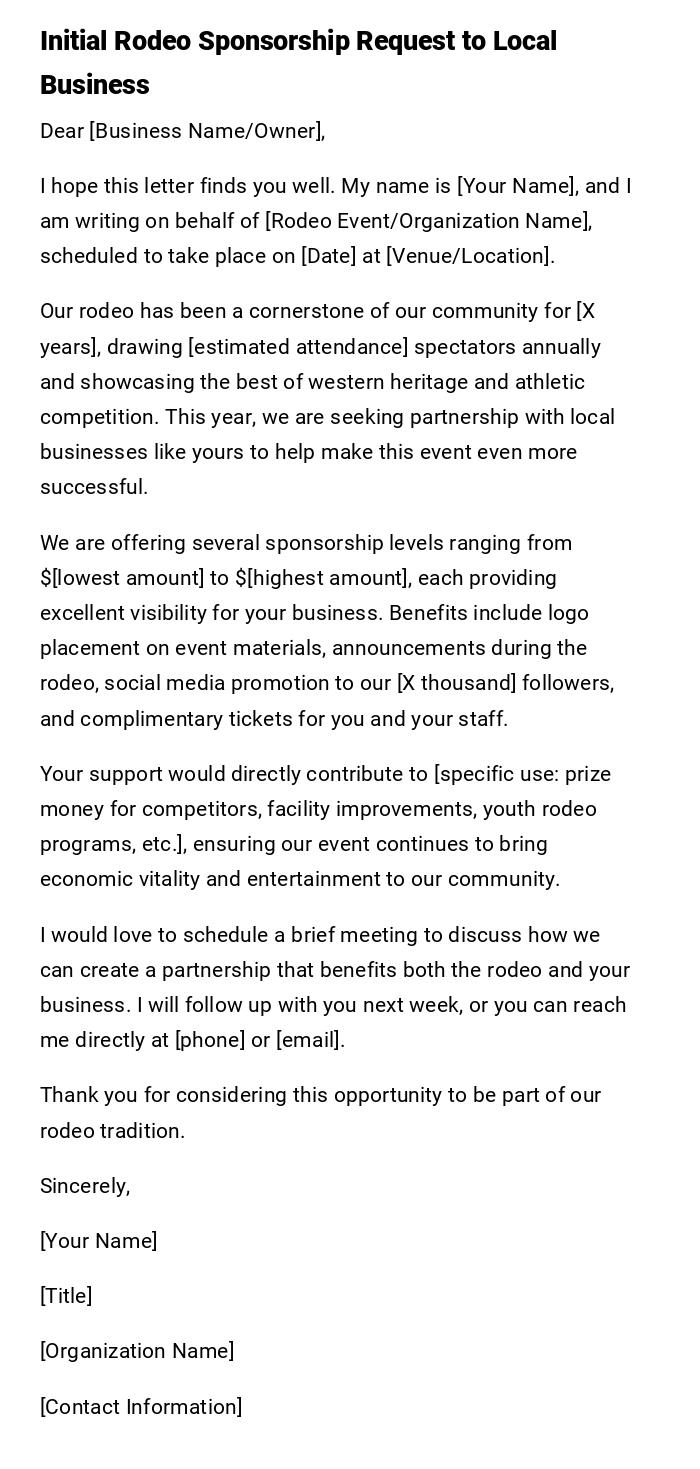
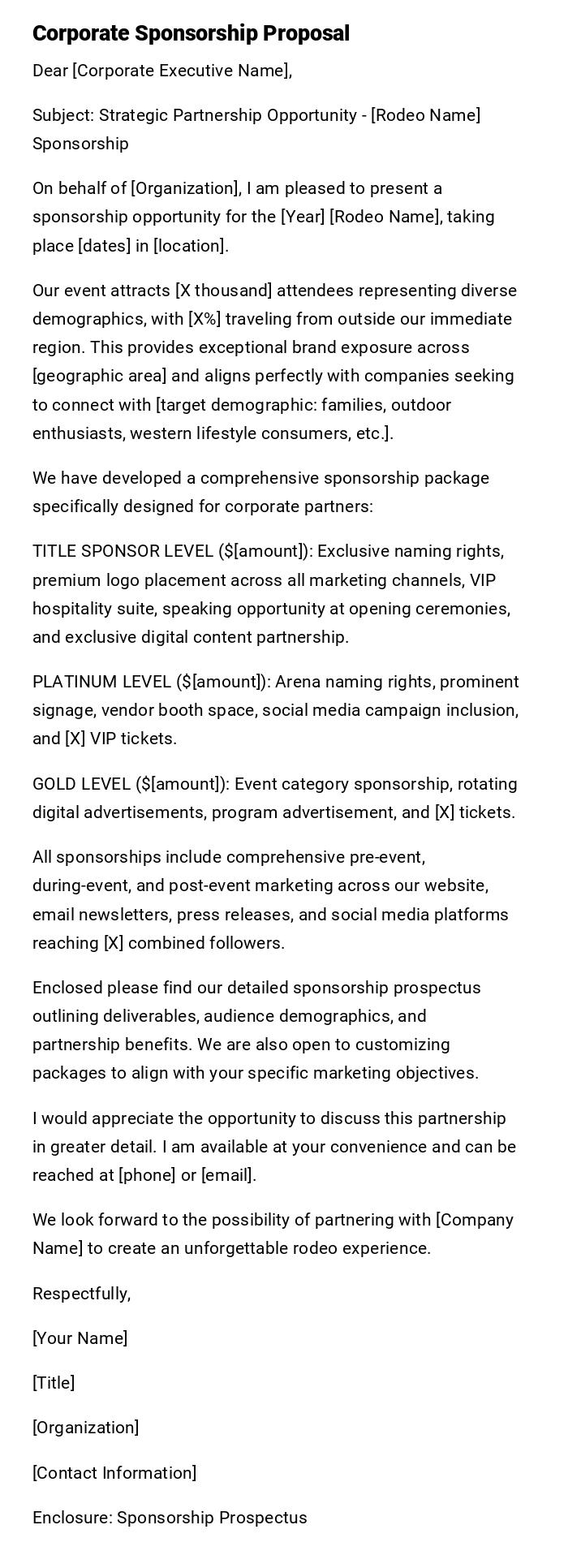
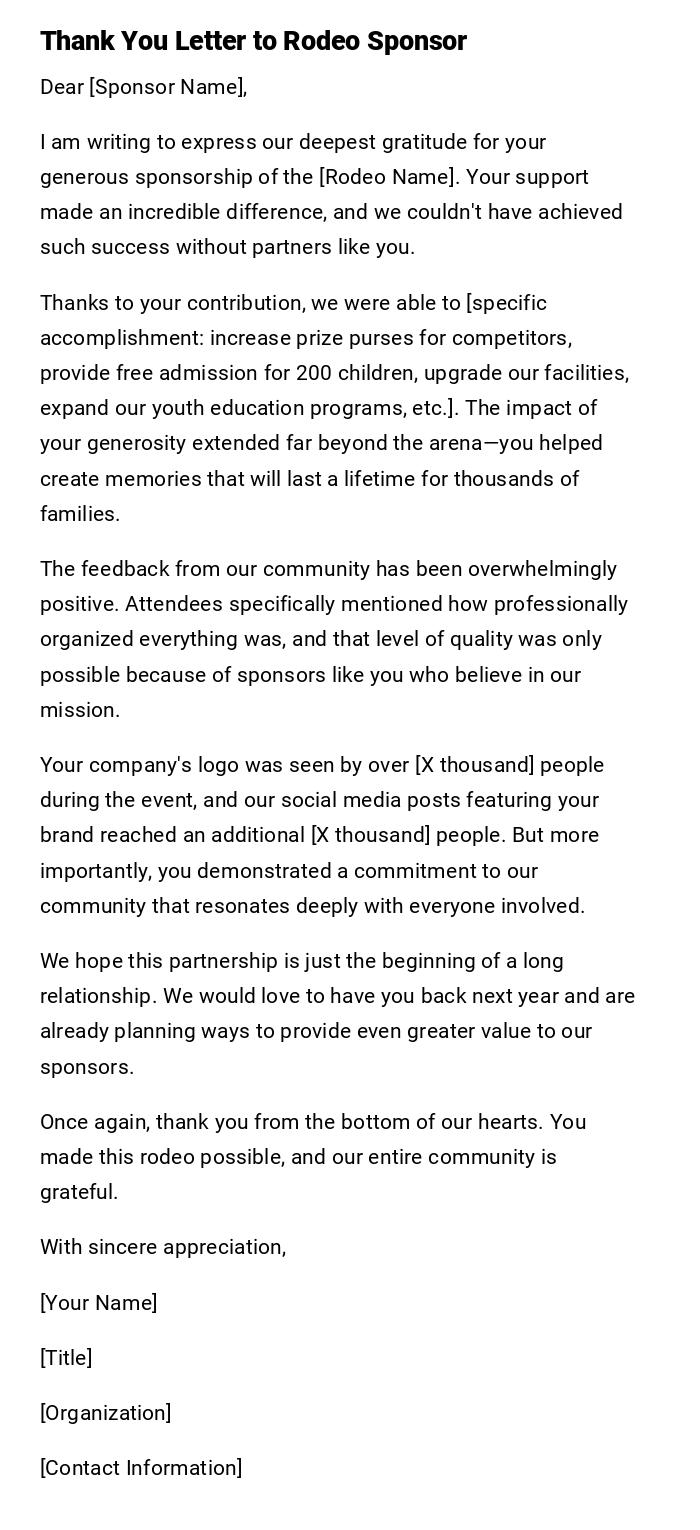
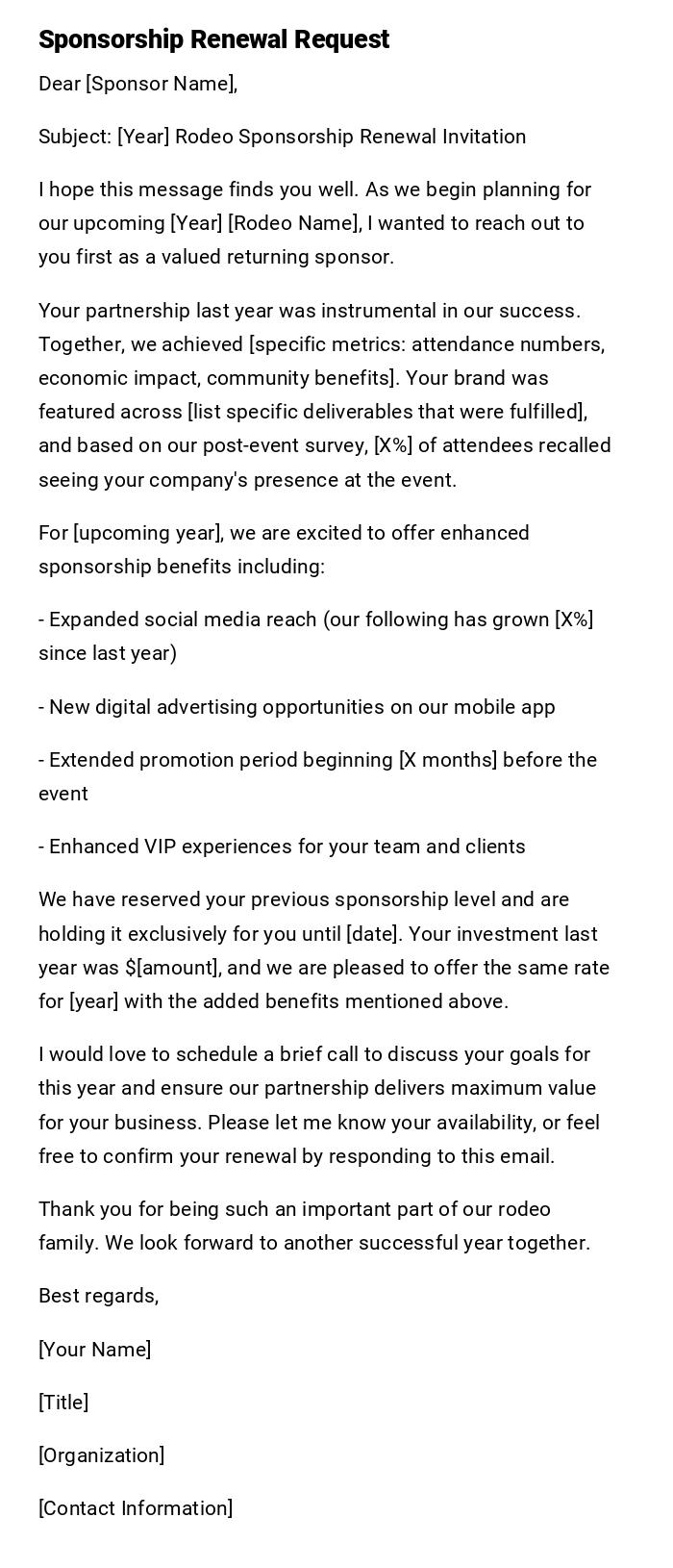
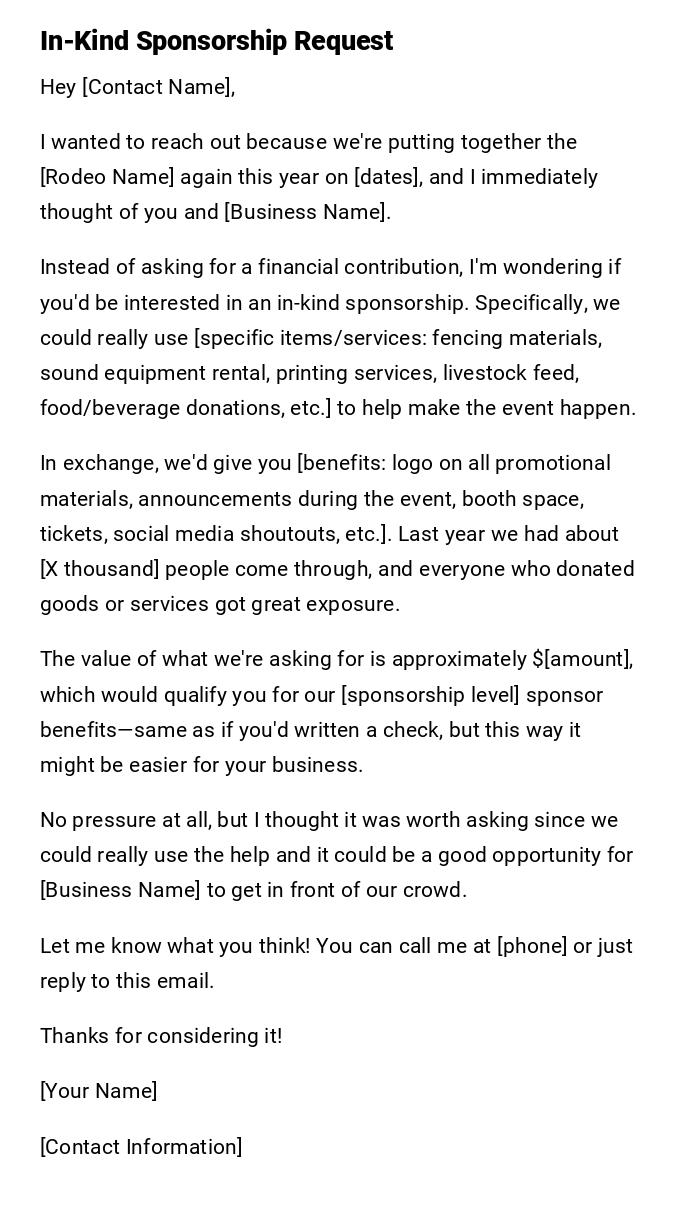
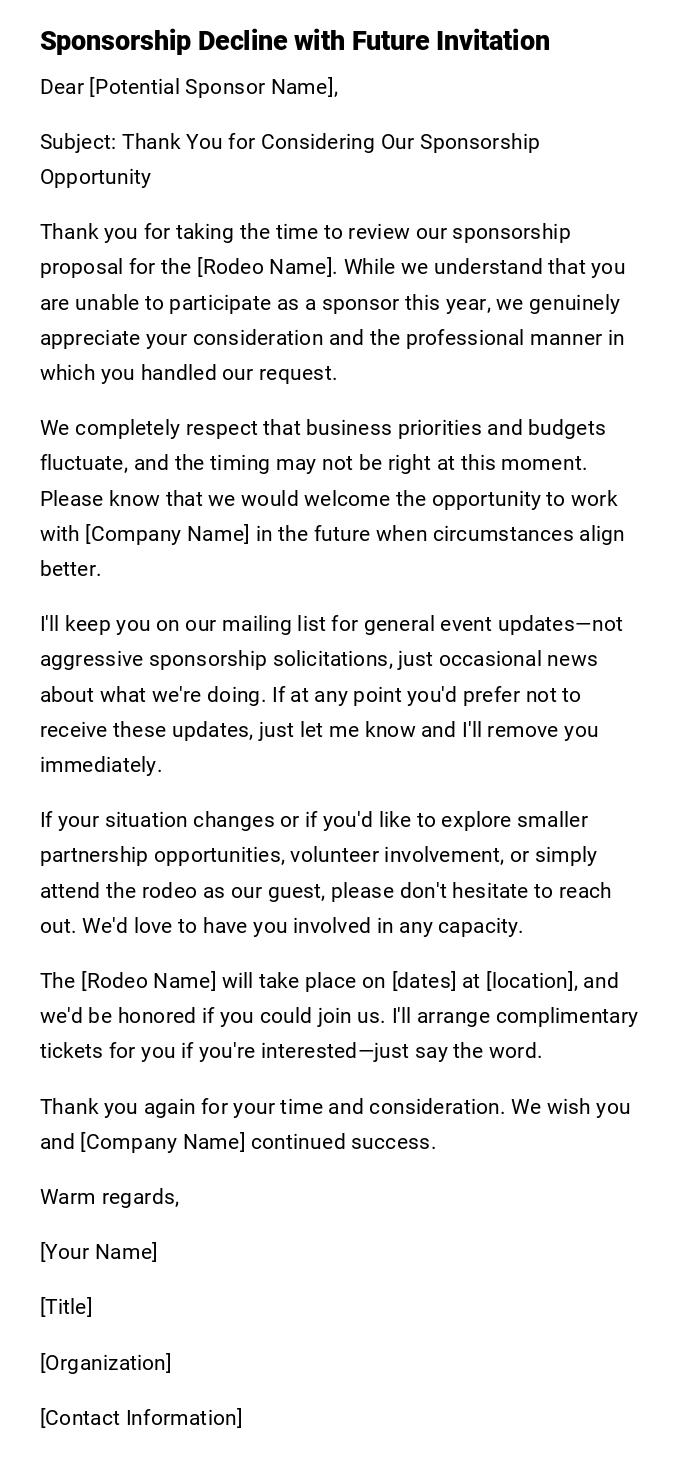
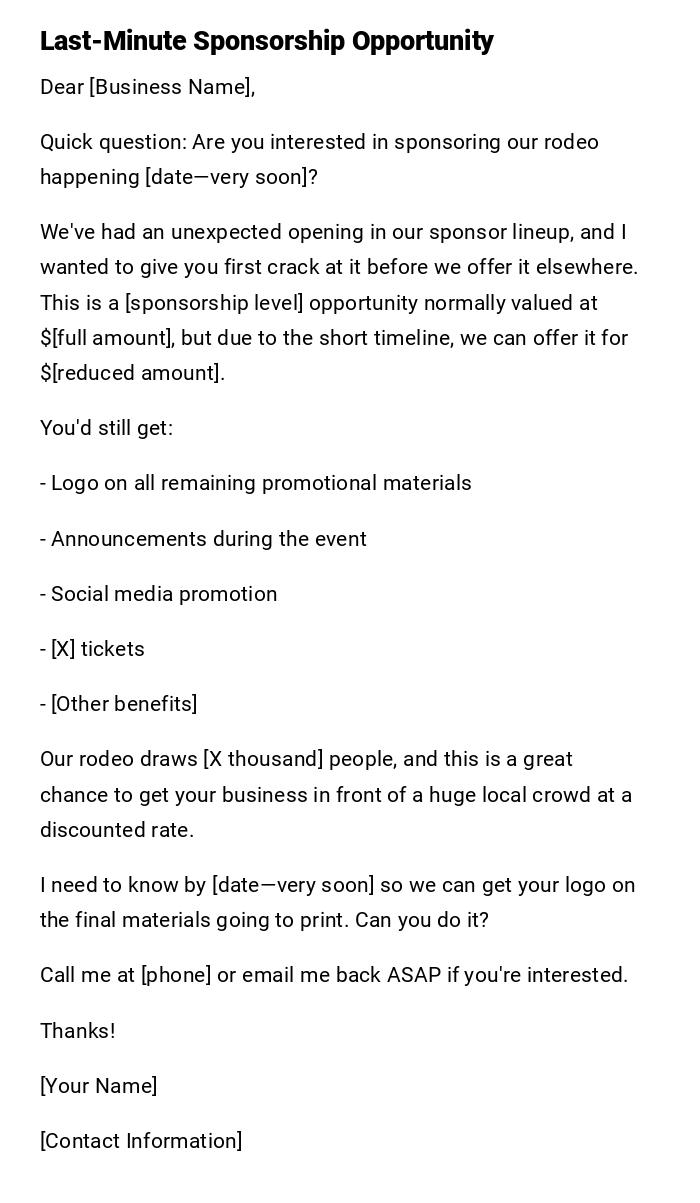


 Download Word Doc
Download Word Doc
 Download PDF
Download PDF